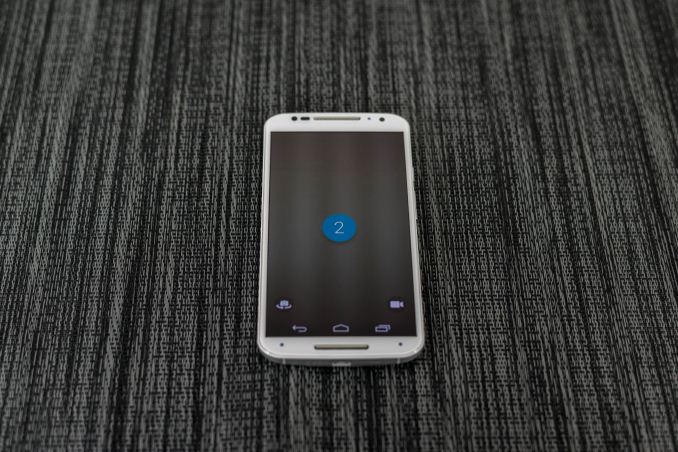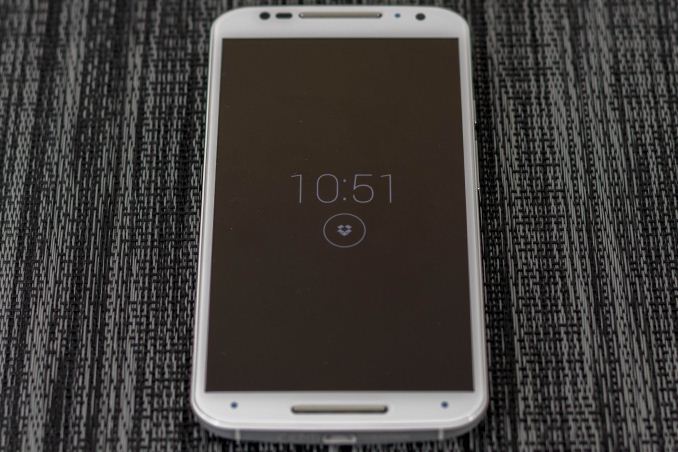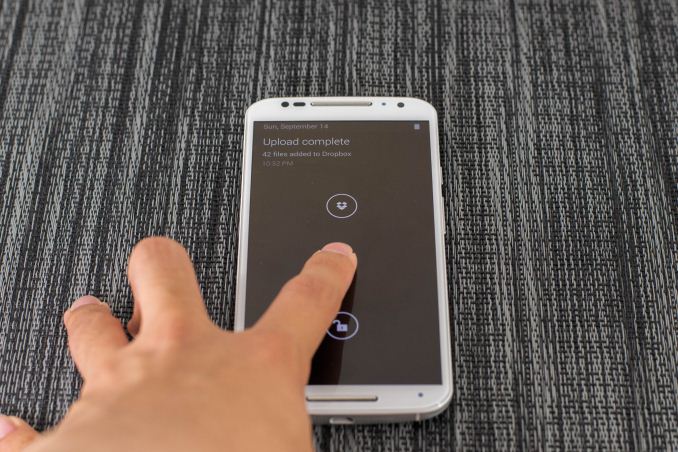The New Motorola Moto X (2nd Gen) Review
by Joshua Ho on September 17, 2014 9:00 AM EST- Posted in
- Smartphones
- Motorola
- Android
- Mobile
Moto Voice
One of the highlight features of the previous Moto X was Touchless Control, and Motorola spent a great deal of time trying to empahsize improvements in this feature with at the launch event. For those unfamiliar with Touchless Control in the previous Moto X, I would reference Brian's Moto X review. For those that don't want to read another review, the quick explanation is that Moto Voice acts as a voice command system, similar to Siri but with integration into Google Now and it works purely based on voice instead of long pressing a home button or a swipe gesture on the navigation keys. With the new Moto X, not too much changes, but there are some key features added. First, we see the ability to assign new keywords other than “Ok Google Now”, which is nice. I’m not really sure how this is enabled, as based upon some digging Motorola is still using a TI C55x DSP to enable low power hotword detection.
For the most part, other than this change I don’t really see a major step forward in functionality, although I’m sure that some will see a great deal of benefit from the voice-enabled selfie feature, which automatically opens the camera app with the countdown as seen above. Voice control continues to be an area where I’m unsure that there’s functionality to be had all the time. For the most part, I only seem to use voice control in situations where my hands are unable to manipulate the phone, which basically means when I’m driving or walking. For better or worse though, this is an area where wearables are much more effective. For example, it’s quick and easy to raise my wrist and ask for navigation to an event while driving compared to trying to reach into my pocket and carefully pull out my phone without dropping it under the seat. While explaining how this happens is a long story, the critical point here is that Moto Voice doesn’t really have a killer use case that isn’t done better by something else.
At any rate, the user interface also changes with the new Moto X. We see a great deal more color and a generally friendlier UI compared to the rather dark theme we saw before. Motorola seems to be following Android UI trends in general with this move, although it will affect battery life on AMOLED panels. The setup process is relatively simple, although there’s definitely a need for a quiet room. Even mild amounts of background noise will complicate setup. I also noticed that differing aural environments could alter the responsiveness of Moto Voice, although this could be due to the function turning itself on and off due to a bug in the ROM.
Moto Display
While Moto Voice is a bit limited in usability, Moto Display continues to be a great feature. For those that are unfamiliar with how Active Display worked in the previous Moto X, I would reference Brian's Moto X review again. For those that aren't familiar with Moto Display, this is effectively a low power mode in the Moto X that will display notifications and the time that also acts as a lockscreen. In order to support this low power mode, it isn't actually a part of Android OS and is programmed by a microcontroller so it isn't possible to take a screenshot of Moto Display.
While what we saw in the original Moto X was fantastic, the new Moto X takes things further by adding Moto Actions. While one part of Moto Actions is waving to silence alarms and phone calls, the other aspect allows for proximity to turn on Moto Display. This means that there’s no longer a need to shake the table or wiggle the phone in order to glance at notifications. While the original Moto X had a similar feature, it relied on the proximity sensor and required precise hand placement in order to turn on the display. Instead, with the new Moto X all that is needed is a hand wave or just getting close to the phone. It doesn’t really need to be accurate either, as pretty much any hand wave over the display will cause Moto Display to activate. In practice, handling of the notifications is still mostly similar, although now there’s the ability to display up to three notifications instead of just one.
While Active Display in the original Moto X was good, the new Moto X really turns it into a fantastic feature. It's hard to really explain because on the surface it seems rather mundane but after using Moto Display it's clear just how much time it saves. The glance time is just right to view notifications and the hand wave/approach action is effortless compared to pressing a home button or tapping the display. There's also no doubt that this helps to improve real world battery life as the seconds used to glance at notifications adds up quickly over time, especially because initial unlock will drive the CPUs to max power to ensure responsiveness.
If I’m honest, I’m not really completely sure how this new feature is implemented either. TI’s MSP430 is gone, and the part that seems to take its place is an STM401 sensor processor, which could be the solution used to enable Moto Display and also acts as a sensor hub. I'm not really sure what drove a change, but it's possible that the MSP430 limited feature expansion.














179 Comments
View All Comments
cwolf78 - Wednesday, September 17, 2014 - link
Some glaring omissions from this review:-Battery Life Talk Time (this has traditionally been a strong point for Motorola - does this continue?)
-Sound Quality (from built speaker and headphone jack)
-Bluetooth compatibility and performance (audio quality and issues connecting to devices)
-Call Quality (speakerphone and earpiece quality)
-Microphone quality (this phone is supposed to have an array of 4 mics.. how well does the noise cancellation work? Can people on the other end hear you clearly?)
Seems like all the aspects of this phone being used as a, well, phone, have been ignored. Usually Motorola is tops in this department. I'd like to know if that continues to be true for this device or if it's just another "Me Too!" device like this review implies.
gg555 - Wednesday, September 24, 2014 - link
Yeah, I'm also disappointed not to see a review of the one of a kind four microphone noise cancellation. In the past, AnandTech is the only site that reviewed noise cancellation. Now no one does.Aqua1ung - Wednesday, September 17, 2014 - link
801? Tsk, tsk, tsk...apertotes - Wednesday, September 17, 2014 - link
10 page review. No mention at all about the lack of microSD. Bye, Anandtech. I've had enough.TheMan876 - Wednesday, September 17, 2014 - link
Lol, what does it matter to you whether it's in the article? It's not there and you already know it's not there. And you know it's very close to Google's AOSP stuff and Google got rid of microSD support forever ago.hansmuff - Wednesday, September 17, 2014 - link
I don't understand this. I thought the 2014 Moto G has Micro-SD and 4.4.4? Is the Moto G not as close to AOSP?TheMan876 - Friday, September 19, 2014 - link
Well, my face is red. I don't pay attention to low end devices. Had no idea.CanvasExtractor - Wednesday, October 15, 2014 - link
Is the Moto G a low-end device to you?soccerballtux - Thursday, September 18, 2014 - link
looks like Josh will be headed to Apple soon too. In fact the entire site will be purchased and rebranded to Appletech. Android reviews will continue but every phone with features similar to iPhones (lack of SD card slot, sealed batteries, etc.) will be praisedCanvasExtractor - Wednesday, October 15, 2014 - link
Google's Nexus Initiative is not AOSP... far from it. Unless you consider dropping a stock browser for Google Chrome and a stock SMS app for Google Hangouts to be "open source" in the least... nope. Google is removing open-source options from Nexus.True AOSP is returning SD capability; the backlash Google experienced with the release of KitKat was apparently disastrous enough to reschedule all their crippled functionality on Android Lemon.